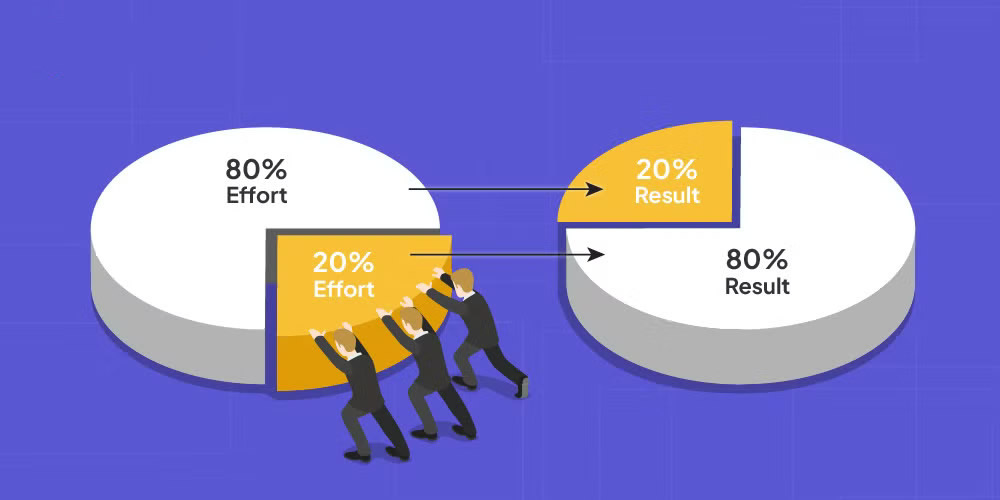The Pareto principle, also known as the 80/20 rule, states that 80% of the results come from 20% of the causes. Learn how to use this principle to identify and leverage the most productive and valuable aspects of your employees’ performance.
Prof. Aécio D’Silva, Ph.D
AquaUniversity
The Pareto principle is a simple but powerful concept that can help you optimize your employees’ performance and satisfaction. It can help you focus on the key factors that drive the most outcomes and eliminate or reduce the ones that waste time and resources.
What is the Pareto principle and how does it apply to employees’ performance?
The Pareto principle, named after the Italian economist Vilfredo Pareto, who observed that 80% of the land in Italy was owned by 20% of the population, is a universal phenomenon that states that in many situations, 80% of the effects come from 20% of the causes. For example, 80% of your sales may come from 20% of your customers, 80% of your complaints may come from 20% of your products, or 80% of your profits may come from 20% of your projects.
The Pareto principle can also apply to your employee’s performance, as it can help you identify and leverage the most productive and valuable aspects of their work and eliminate or reduce the ones that are less impactful or inefficient. For example, 80% of your employees’ output may come from 20% of their time, 80% of your employee’s satisfaction may come from 20% of their tasks, or 80% of your employees’ growth may come from 20% of their skills.
How to use the Pareto principle to boost your employees’ performance?
To use the Pareto principle to boost your employees’ performance, you need to follow four steps: Analyze, Prioritize, Delegate, and Evaluate. These steps will help you to assess the current situation, identify the key factors that drive the most results, allocate the resources and responsibilities accordingly, and monitor the progress and outcomes.
- Analyze: The first step is to analyze your employees’ performance data, such as their output, quality, efficiency, satisfaction, and feedback. You can use various tools and methods to collect and visualize the data, such as surveys, interviews, reports, charts, and graphs. You should look for patterns and trends that reveal the distribution of the effects and the causes and try to find the 80/20 ratio in each aspect of your employees’ performance.
- Prioritize: The second step is to prioritize the most important and impactful factors that contribute to your employees’ performance, based on the analysis. You should focus on the 20% of the causes that generate 80% of the effects and rank them according to their value and urgency. You should also identify 80% of the causes that generate 20% of the effects, and decide whether to eliminate, reduce, or improve them.
- Delegate: The third step is to delegate the tasks and responsibilities according to the priorities and allocate the resources and time accordingly. You should assign the most critical and valuable tasks to your best and most motivated employees and provide them with the necessary support and autonomy. You should also delegate the less important and less impactful tasks to your less skilled or less engaged employees and provide them with the necessary guidance and feedback.
- Evaluate: The fourth and final step is to evaluate the results and outcomes of your employees’ performance, based on the Pareto principle. You should measure and compare the output, quality, efficiency, satisfaction, and feedback of your employees before and after applying the principle and look for improvements and gaps. You should also review and revise the priorities, tasks, and resources as needed, and celebrate and reward the achievements and progress.
What are the benefits of using the Pareto principle for your employees’ performance?
Using the Pareto principle for your employees’ performance can offer many benefits, such as:
- It can increase the productivity and efficiency of your employees, as they can focus on the most important and impactful tasks and avoid wasting time and resources on the less relevant and less effective ones.
- It can increase the satisfaction and motivation of your employees, as they can work on the tasks that match their skills and interests and feel more valued and recognized for their contributions.
- It can increase the growth and development of your employees, as they can learn from the best practices and examples and acquire new skills and knowledge that can enhance their performance and career prospects.
- It can increase the innovation and creativity of your employees, as they can explore new possibilities and solutions, and experiment with different approaches and methods.
What are the challenges and limitations of using the Pareto principle for your employees’ performance?
Using the Pareto principle for your employee’s performance can also pose some challenges and limitations, such as:
- It can be difficult and time-consuming to collect and analyze the data, and to find the accurate and reliable 80/20 ratio in each aspect of your employees’ performance.
- It can be subjective and biased to prioritize and rank the factors that affect your employee’s performance, and to assign the tasks and responsibilities accordingly.
- It can be risky and unpredictable to delegate and allocate resources and time based on the Pareto principle, as it may not account for the changing and dynamic nature of the work environment and the employees’ needs and preferences.
- It can be ethically and legally problematic to use the Pareto principle for your employees’ performance, as it may create or reinforce inequalities and disparities among your employees and affect their morale and well-being.
How to overcome the challenges and limitations of using the Pareto principle for your employee’s performance?
To overcome the challenges and limitations of using the Pareto principle for your employee’s performance, you can adopt some strategies, such as:
- You can use a systematic and data-driven approach to collect and analyze the data, and to find the 80/20 ratio in each aspect of your employees’ performance. You can use various sources and methods to gather and visualize the data, such as surveys, interviews, reports, charts, and graphs. You can also use statistical and analytical tools and techniques to verify and validate the data, such as correlation, regression, and hypothesis testing.
- You can use a collaborative and inclusive approach to prioritize and rank the factors that affect your employees’ performance, and to assign the tasks and responsibilities accordingly. You can involve your employees in the decision-making process and solicit their input and feedback. You can also use objective and transparent criteria and indicators to evaluate and compare the factors, such as value, urgency, impact, and feasibility.
- You can use a flexible and adaptive approach to delegate and allocate resources and time based on the Pareto principle, and to account for the changing and dynamic nature of the work environment and the employees’ needs and preferences. You can monitor and adjust the priorities, tasks, and resources as needed, and respond to the emerging opportunities and challenges. You can also provide your employees with the necessary support and autonomy and encourage them to communicate and collaborate with each other.
- You can use an ethical and responsible approach to use the Pareto principle for your employees’ performance, to avoid or reduce the inequalities and disparities among your employees, and to protect their morale and well-being. You can respect and recognize the diversity and uniqueness of your employees and provide them with equal opportunities and fair treatment. You can also foster a culture of trust and respect and promote the values and principles of your organization.
The Pareto Principle with an example
The Pareto principle, also known as the 80/20 rule, is a concept that states that in many situations, 80% of the effects come from 20% of the causes. For example, 80% of your sales may come from 20% of your customers, or 80% of your complaints may come from 20% of your products. The idea behind the Pareto principle is to identify and focus on the most important and impactful aspects of a situation and eliminate or reduce the ones that are less relevant or less effective.
One example of the Pareto principle in action is the carpet tiles designed by Interface, a company that produces modular flooring systems. The company wanted to create carpet tiles that could be installed in any orientation, without requiring precise alignment or matching patterns. This would reduce the installation time and waste and increase the flexibility and durability of the tiles. The company used the Pareto principle to analyze its design challenge and find the 80/20 ratio in each aspect of its performance. They discovered that 80% of their customers’ satisfaction came from 20% of their design features, such as the color, texture, and pattern of the tiles. They also discovered that 80% of their installation waste came from 20% of their design flaws, such as the size, shape, and orientation of the tiles. Based on these findings, the company prioritized and delegated the tasks and resources accordingly, and created carpet tiles that featured a random, non-directional pattern and gradations of colors. These tiles could be installed in any direction and order and blended seamlessly with each other and the environment.
How can I apply this to my company’s performance review process?
The Pareto principle can help you improve your company’s performance review process by helping you identify and focus on the most important and impactful aspects of your employees’ performance and eliminate or reduce the ones that are less relevant or less effective. Here are some possible steps you can follow to apply the Pareto principle to your performance review process:
- Analyze: Before conducting the performance review, collect and analyze the data related to your employees’ performance, such as their output, quality, efficiency, satisfaction, and feedback. You can use various tools and methods to gather and visualize the data, such as surveys, interviews, reports, charts, and graphs. You should look for patterns and trends that reveal the distribution of the effects and the causes and try to find the 80/20 ratio in each aspect of your employees’ performance.
- Prioritize: Based on the analysis, prioritize the most important and impactful factors that contribute to your employees’ performance, and set the goals and expectations accordingly. You should focus on the 20% of the causes that generate 80% of the effects and rank them according to their value and urgency. You should also identify 80% of the causes that generate 20% of the effects, and decide whether to eliminate, reduce, or improve them.
- Delegate: During the performance review, delegate the tasks and responsibilities according to the priorities, and allocate the resources and time accordingly. You should assign the most critical and valuable tasks to your best and most motivated employees and provide them with the necessary support and autonomy. You should also delegate the less important and less impactful tasks to your less skilled or less engaged employees and provide them with the necessary guidance and feedback.
- Evaluate: After the performance review, evaluate the results and outcomes of your employees’ performance, based on the Pareto principle. You should measure and compare the output, quality, efficiency, satisfaction, and feedback of your employees before and after applying the principle and look for improvements and gaps. You should also review and revise the priorities, tasks, and resources as needed, and celebrate and reward the achievements and progress.
By applying the Pareto principle to your performance review process, you can optimize your employees’ performance and satisfaction, and increase your company’s productivity and profitability.
In conclusion, using the Pareto principle for your employees’ performance can help you optimize your employees’ performance and satisfaction. It can help you focus on the key factors that drive the most outcomes and eliminate or reduce the ones that waste time and resources. By following the four steps of Analyze, Prioritize, Delegate, and Evaluate, you can apply the Pareto principle to your employee’s performance, and enjoy the benefits of increased productivity, efficiency, satisfaction, motivation, growth, development, innovation, and creativity.
References
- Koch, R. (2011). *The 80/20 principle: The secret to achieving more with less*. Crown Business.
- Manktelow, J., & Carlson, A. (2019). *Pareto analysis: Choosing the most important changes to make*. Retrieved from https://www.mindtools.com/pages/article/newTED_01.htm
- Perry, R. (2018). *80/20 sales and marketing: The definitive guide to working less and making more*. Entrepreneur Press.
- Trunk, P. (2007). *How to apply the 80/20 rule to your employees*. Retrieved from https://blog.penelopetrunk.com/2007/03/29/how-to-apply-the-8020-rule-to-your-employees/






